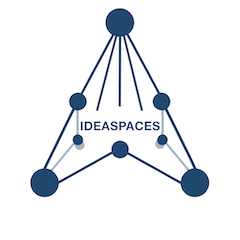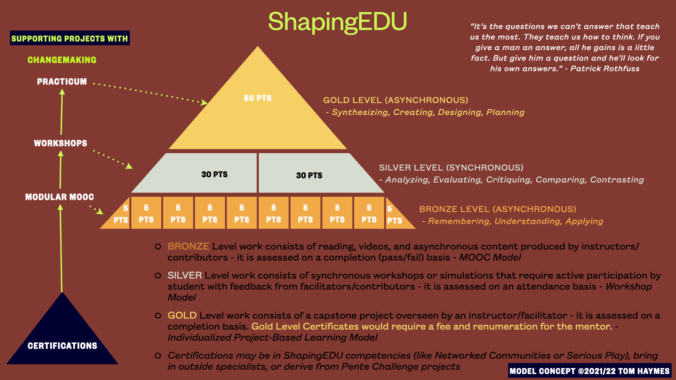Systemically Transforming Instruction Through Strategic Use of Technology Tools
Technology allows us to think about teaching and learning differently. Digital technology no longer requires learning to be confined to specific physical locations and times because that’s where the classrooms and books are. Instead, we can develop pedagogy that is highly portable in both space and time.
These approaches allow us to prioritize the needs of the student over the logistics of teaching and learning. They make it possible to mold the learning experience around the busy schedules of mid-career professionals but still create deep learning experiences that will change how learners approach the challenges of their practice.
This approach is based on the Hybrid Plus strategy outlined in my books, Learn at Your Own Risk (Atbosh, 2020). Under this strategy, we can separate all pedagogy into synchronous and asynchronous activities. We can then create communities of learning by applying these elements interchangeably when most appropriate to the course outcomes.
The driving factor is not logistics, but the educational appropriateness of an activity to live collaboration with fellow learners and experts in the field versus learning that can and should be engaged at the time and place of the learner’s choosing.
The planned certificate contains three levels of interaction. At its core is a synchronous set of activities that can happen in a two-day retreat or spread over several weeks of videoconferencing sessions.
Below this level are a series of asynchronous learning modules that support and deepen the work that happens during the live sessions. Students can complete these modules before or after the live session and in any order.
Above this level, the learner will work directly with a faculty member to produce a tangible work product related to the subject of the course/certificate. This level combines both synchronous and asynchronous elements.
Synchronous Activities Summary
- Provide a framework for analyzing and acting in a complex learning environment
- Supplement the framework with context provided by a scholar or practitioner relevant to the course
- Apply lessons through active-learning scenarios with specific emphasis on the impact of communications, technology, and culture on modern educational practice
- Debrief with expert on lessons learned through the scenario
- Conclusion: Feedback and practicum options
Asynchronous Activities Summary
- Supplemental learning through asynchronous activities online
- Foundational level work can be completed in any sequence, before or after synchronous level events
- Creation of tangible work products developed in close partnership with experts in the field
The structure of the courses/certificates is structured around three principles: simplicity, flexibility, and antifragility. The courses are based on well-established frameworks of pedagogical practice and leverage digital strategies to create novel forms of learning opportunities. It is essential that learning activities have a purpose.
While there are many schemas that have been developed to address activities learning, we have applied the rubric developed by Diana Laurillard in Teaching as a Design Science (Laurillard, 2012). She outlines six key tasks that all learners should perform to achieve deep learning and show mastery of a subject: Acquisition, Inquiry, Discussion, Collaboration, Practice, and Production. No one part of the learning experience hits all six of these practices. However, the overall certificate structure engages all of them.
There are many circumstances where Remote Teaching may be required. The entire Live Session process can be easily transitioned to a videoconferencing modality. Indeed, we may take advantage of this technology to give us more flexibility and reach for bringing in outside experts throughout the process.
It is entirely feasible to move the 7 segments of the Live Session into videoconferencing blocks of similar length. However, since remote learning is harder on attention spans, it is recommended that the sessions be spread out over 7 working days (or more) with no more than one segment per day at a similar length as in a live session. Additional tools may need to be applied to facilitate conversations that would otherwise happen spontaneously when participants are in the room together.
Complementing the synchronous sessions with asynchronous modules that participants can engage with before, during, or after the live sessions will deepen and broaden the experience of the course. The plan is to provide at least 10 modules for each course that should take 1-2 hours per module to complete.
Students may select modules based on interest. Not all modules will be required to complete a certificate. Instead, participants will complete any four of them for the basic certificate and 6-10 of them for the advanced certificate.
Those participants seeking to have a more complete experience and create a tangible work project will be partnered with an expert to develop a project or artifact. Ideally, this project will tie directly into the duties that the learner already performs as part of his or her job responsibilities.
This model leverages all the affordances of digital technology described in my book Discovering Digital Humanity (Atbosh, 2022) to create a truly flexible and fluid instructional module. We could apply it in a variety of circumstances, from K12 to lifelong learning, but is particularly appropriate for students who have other challenges in life.
Ideaspaces can help design courseware using this model for your particular learning project. Email us to find out more.

